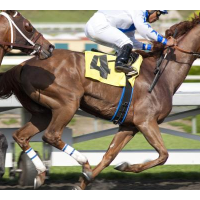Nine Dead Horses in Nine Days at Del Mar Racetrack
 (photo: Associated Press)
(photo: Associated Press)
(Editor’s note: Nine animals were harmed in the making of this story.)
Del Mar racetrack promises an experience that is as “Cool as Ever.” What’s not cool is nine dead horses in the first nine days of this year’s 75th annual summer meet. Only four died last year.
Race horses die at the track all too frequently―between 200 and 400 a year in California. It is estimated that 24 horses die every week on U.S. racetracks.
But a cluster of deaths like this is unusual. Twelve died at Del Mar in 2011; five the year before, according to the California Horse Racing Board. Moving backward in time beginning with 2009, annual deaths totaled 9, 14, 12, 13, 23, 26, 17, 22 and finally 13 in 2001.
The usual suspects in horse racing deaths include breeding, medication, track surfaces and training, sometimes with nefarious overtones. A spate of mysterious sudden deaths in California last year―one trainer alone lost seven horses in 16 months―were never solved. But those horses were just keeling over with cardiac problems and internal bleeding issues.
So far, Del Mar authorities have focused on the track itself. They waxed the synthetic Polytrack and watered and aerated the turf track to slow things down. They also moved a rail to give the horses more room on turf.
That seemed to do it for Dr. Rick Arthur, the Racing Board medical director. “Everything they've done makes sense to me and hopefully it will take care of whatever issues there were,” he told the Los Angeles Times.
One horse died racing opening day, July 17. A week later, Grass Stakes winner Dance With Fate was put down after his bridle came loose during a training exercise and he crashed into the outer chain-link fence. Another horse was found dead in the barn that day. Two died in races the next day and two more racing the day after that. One died during a workout last Sunday and another died of a heart attach that day.
Horse racing officials have gone back and forth on track surfaces for years. In May 2006, after annual death counts hovered over 300, the Racing Board decided to get rid of dirt tracks in California and change to synthetics by the end of 2007. It issued an edict to racetrack owners throughout the state to comply or risk losing racing dates in 2008. California was the first state to mandate that its major thoroughbred tracks make the conversion.
The death counts held steady and critics of the synthetics said the state had move precipitously. In April 2009, the board began to hand out waivers and let tracks convert back to dirt.
Turf racing resumed at Del Mar on Wednesday. No horses died.
–Ken Broder
To Learn More:
Del Mar Takes Steps For Safer Racing (by Ed Zieralski, U-T San Diego)
Del Mar Makes Changes after Deaths of Nine Horses (by Eric Sondheimer, Los Angeles Times)
Del Mar Race Track—the Death Track? (by Richard Georges, Pulpdiddy)
No Answers for Mysterious Racehorse Deaths on California Tracks (by Ken Broder, AllGov California)
- Top Stories
- Controversies
- Where is the Money Going?
- California and the Nation
- Appointments and Resignations
- Unusual News
- Latest News
- California Forbids U.S. Immigration Agents from Pretending to be Police
- California Lawmakers Urged to Strip “Self-Dealing” Tax Board of Its Duties
- Big Oil’s Grip on California
- Santa Cruz Police See Homeland Security Betrayal in Use of Gang Roundup as Cover for Immigration Raid
- Oil Companies Face Deadline to Stop Polluting California Groundwater





